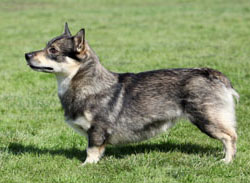Swedish Vallhunds are small, double-coated dogs that come in any color from red to gray. Their coats have a sable pattern and are medium in length. The undercoat is dense and soft and the topcoat is close and tight. These dogs naturally come with a full curl tail, stub tail, or no tail (bobtail). Their eyes are oval and dark brown, and their ears are medium in size. Swedish Vallhunds measure 11.5 to 13.5 inches tall at the shoulder and weigh 20 to 30 pounds.
These dogs are always in the mood for hugs, pats, treats, and praise.
Energetic, intelligent, and alert, Swedish Vallhunds make great companions for active families. They need daily exercise and a lot of free play to remain mentally and physically healthy. This breed is a good choice for older children and it makes an excellent watchdog.
The Swedish Vallhund is frequently referred to as "a big dog in a small body."
Energetic, friendly, intelligent, and eager to please, Swedish Vallhunds fit in well with calm children and active families. They are not shy or vicious and they get along with nearly everyone. They are watchful and alert, though, and will bark when strangers approach. These dogs make great household pets.
A playful and active breed, the Swedish Vallhund needs a lot of exercise to remain physically and mentally healthy. Daily walks and time outdoors is important, but these dogs need to live inside with their human families. Swedish Vallhunds are loving and affectionate and need time with and attention from their loved ones.
These dogs are always in the mood for hugs, pats, treats, and praise. Whether this comes from family members or strangers seems to matter little to the breed. Visitors and members of the household should be prepared to listen to the Swedish Vallhund chatter on and on when the mood strikes.
Swedish Vallhunds are one of the healthier dog breeds, but that is not a guarantee that any individual dog will be free of genetic illness or other health problems. Purchasing or adopting from a reputable source helps ensure a healthy puppy.
This breed is prone to developing congenital hip dysplasia and patellar luxation, both of which can negatively affect mobility and quality of life. Certain eye diseases are also known to affect these dogs, and some may lead to permanent blindness. Regular eye examinations can detect some problems early enough for treatment to be beneficial.
Swedish Vallhunds generally live a full life of 12 to 14 years, provided they receive routine veterinary care, timely vaccinations, daily exercise, and proper nutrition.
Positive reinforcement is generally the best way to reach the Swedish Vallhund. These dogs generally respond very well to praise, play, and treat rewards, but it may take some time to figure out the best motivation for individual dogs. Kindness is important, and training should always be firm and consistent. Harsh criticism and punishment will only lead to regression and increased stubbornness.
Swedish Vallhunds learn quickly and easily, but they are independent thinkers that may require extra time and patience. Designing training methods to challenge the breed's creative mind and love for problem solving is helpful. Training sessions that are short and interesting are generally more effective than long, repetitive sessions.
Socialization from an early age is an important part of helping the Swedish Vallhund grow into a tolerant and confident adult without the tendency to be overly fearful or suspicious of new situations and people. Puppy kindergarten, outings to local businesses, trips to see neighbors and friends, and visits to the dog park are all helpful and can provide continuing socialization throughout life.
Grooming the Swedish Vallhund is easy; these dogs need only occasional brushing and bathing to maintain their medium-length coat. Shedding can be a problem, but increasing brushings to two or three times each week should be sufficient to keep loose hair under control and off furniture and clothing. Trimming the hair on the footpads is also beneficial.
These dogs generally only need bathing if they get into something stinky or harmful. A pH-balanced shampoo designed for use on dogs will gently clean the Swedish Vallhund's coat without drying the skin or causing irritation. Thorough rinsing is important to remove all traces of soap from the skin and hair.
The nails need trimming every week or two to prevent potentially painful snags and breaks, and daily toothbrushing will help prevent gum disease, tooth decay, and bad breath. A quick check of the ears each week will assist in early diagnosis and treatment of ear infections. Excess ear wax, dirt, and debris can be washed from the outer ear with a cotton ball and veterinarian-approved otic cleanser.
Swedish Vallhunds likely date back more than 1000 years, to the time of the Vikings in Sweden. They were known as the "Viking Dog," or "Vikingarnas Hund," and they strongly resembled Corgis. Due to physical similarities between the two breeds, historians believe that either the Swedish Vallhund was brought to Wales during the 8th or 9th century, or the Corgi was brought to Sweden.
Frequently used as farm dogs, cattle herders, vermin chasers, and watchdogs, the Swedish Vallhund was commonly found on small and large farms. Still, the breed almost became extinct in the 1940s. Fortunately, Count Bjorn von Rosen of Sweden set out to save the breed and the breed's numbers gradually increased.
The breed's popularity surged in Britain and Sweden after the Swedish Kennel Club recognized it in 1943. The dogs did not make their way to the United States until 1983. Today, they are popular companions for families.
The American Kennel Club officially recognized the Swedish Vallhund in 2007.

